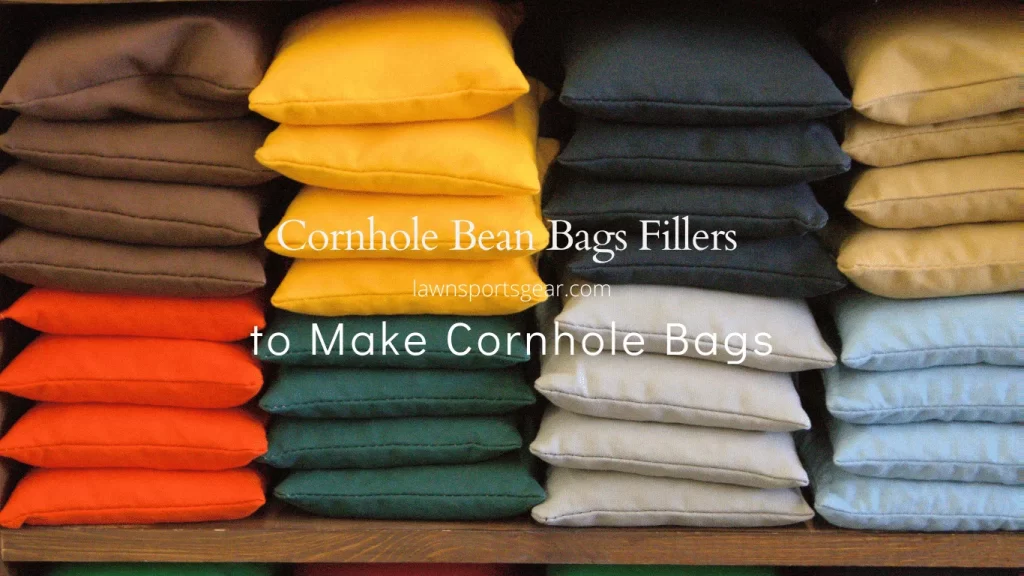This article talks about the best cornhole bean bags fillers to make cornhole bags. These fillers help to create or sew bags for playing cornhole outdoor games.

List of Cornhole Bean Bag Fillers
Table of Contents
- Bean Filling
- Buckwheat Hulls
- Poly Pellets
- Rice
- Sand
- Steel Cut Oats, Groats, or Pearled Barley
- Wood Pellets
- Modeling Clay
- Cedar Chips & Bamboo Shoots
Each one of these fillers has its positive and negative points. The following information helps you in your purchasing decision.
Bean Fillers for Cornhole Bean Bags:
- Cheap
- Available
- Beans are lightweight.
- Beans are hygroscopic, which means they will absorb and retain moisture.
- Beans (and other grains) will mold if exposed to excess moisture and heat.
- Produces a rugged bag that is not as durable and will wear on the stitching faster than other fillers.
Buckwheat Hulls Fillers for Cornhole Bean Bags:
- Cheap & heavy.
- Not available; must be ordered online.
- Buckwheat will not retain moisture, so it is recommended to pre-moisten the hulls for easy seeding.
- Produces a rugged bag that has little give but is also brittle.
- Very hard on the stitching of the bag.
- Buckwheat will mold if exposed to excess moisture and heat.
Poly Pellets as Cornhole Bean Bags Fillers:
- A bit expensive
- When dry, they are very lightweight
- They do not absorb moisture from the air when dry.
- They do not require any pre-moistening or treatment and do not mold when dry.
- They are very durable when dry.
- Produces a bag that is not entirely waterproof but close enough to be functional in all weather conditions.
- They can swell up to 2 or 3 times their dry size when wet.
- Needs a more giant hole than the standard 5/8″, and the 6mm (1/4″) hole size is recommended when using poly pellets.
- Using a 5/8″ or larger hole size with poly pellets will reduce the durability of your bags, causing them to wear out faster.
Cornhole Bean Bags Fillers Rice:
- Cheap
- Available in local stores, grocery, and bulk stores.
- Heavier than other fillers but not as heavy as beans.
- It will not absorb moisture from the air, so there is no need to treat it before seeding.
- Produces a bag that is not as durable as other fillers.
- Rice will mold if exposed to excess moisture and heat.
- Lighter in color than most other filler options.
- Fades to a yellow color if exposed to sunlight for extended periods.
- Rice requires a larger hole size than the standard 5/8″, and the 6mm (1/4″) hole size is recommended.
- Using a 5/8″ or larger hole size with rice will reduce the durability of your bags, causing them to wear out faster.
Sand for Cornhole Bags Fillers:
- Cheap
- Available in local stores, grocery, and bulk stores.
- Sand is weighty for its size.
- Sand will not retain moisture, so it is recommended to pre-moisten the sand before seeding.
- Sand produces a bag that is not as durable as other fillers and will wear on the stitching faster than other fillers.
- Sand will mold if exposed to excess moisture and heat.
- Sand is not very visually appealing.
You may read this article too: How to Wash Cornhole Bags
Steel Cut Oats, Groats, or Pearled Barley Fillers for Cornhole Bags:
- Cheap
- Available in local stores, grocery, and bulk stores.
- Heavier than other fillers but not as heavy as beans.
- Will not absorb moisture from the air, so no need to treat it before seeding.
- Produces a bag that is not as durable as other fillers.
- Molds if exposed to excess moisture and heat.
- Lighter in color than most other filler options.
- Requires a larger hole size than the standard 5/8″, and the 6mm (1/4″) hole size is recommended.
- Using a 5/8″ or larger hole size with them will reduce the durability of your bags, causing them to wear out faster.
Wood Pellets Fillers for Cornhole Bean Bags:
- Cheap
- Moisture resistant
- Available in local stores.
- Produces a bag that is not completely waterproof but close enough to be functional in all weather conditions.
- A little more expensive than other fillers.
- Bags may wear out quicker if you use a 5/8″ or larger hole size with wood pellets.
Don’t forget to read How to Make Cornhole Boards Following Easy Steps
Modeling Clay for Cornhole Bean Bags Fillers:
- Cheap
- Available at local stores, grocery, and bulk stores.
- Typically used by children for arts and crafts but is also used in the medical field to make molds.
- Produces a bag that is not as durable as other fillers.
- Modeling clay will mold if exposed to excess moisture and heat.
- Weighs more than most fillers.
- It requires a larger hole size than the standard 5/8″, and the 6mm (1/4″) hole size is recommended.
- Using a 5/8″ or larger hole size with modeling clay will reduce the durability of your bags, causing them to wear out faster.
- Variations of colors and consistency are available.
Cedar Chips, Bamboo Shoots Fillers for Cornhole Bags:
- Limited availability
- Mildly aromatic.
- Produces a bag that is not entirely waterproof but close enough to be functional in all weather conditions.
- A little more expensive than other fillers.
- May mold if exposed to excess moisture and heat.
- Requires a larger hole size.
- Using a 5/8″ or larger hole size with cedar chips will reduce the durability of your bags, causing them to wear out faster.
- Available in a wide variety of colors and consistency.
Now, you have all the ideas of cornhole bean bags fillers. You can start sewing the bags and ready for the next match.

Lorraine is a mother of two kids; one goes to college and another still reading in school. During her childhood, she wondered how people throw the bags in cornhole boards, how rings get properly in ring toss games. So, she mastered the tricks and started writing the blogs while giving time to the kids.
